Some flowers bloom beautifully and then they’re gone—you have to replant them before the next growing season to enjoy them again next year. But then other flowers bloom and bloom again every year—we call them perennials.
Whether you’re creating a new garden, refreshing an old one, or adding more flowers to your indoor displays, perennials can be an inspired choice. In this post, we’ll show you how perennials compare to annuals and explore many different varieties, including long-blooming, sun- and shade-loving, and tall perennials. Let’s get right on to it!
Perennials vs. Annuals
Perennial flowers spring back to life every year, unlike annuals, which die after they flower. Perennials usually shed their petals and the top part of the plant after flowering, but their lower part enters dormancy throughout the winter. The following spring, the same root pushes forth new growth.
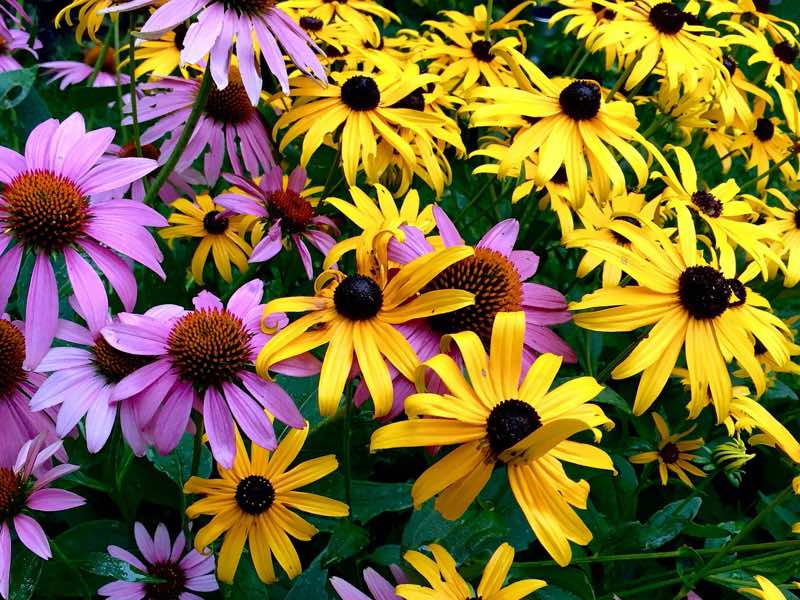
Because they grow again every year, perennial flowers usually require less gardening work than annuals—you can leave them where they are over winter without worrying too much about them. If you like having a beautiful garden but would rather not break a sweat, perennials are the way to go.
Many annuals drop seeds on the ground from which new flowers can spring during the next flowering season. That means that not all annuals need to be replanted every spring, though their growth from seed may be harder to control.
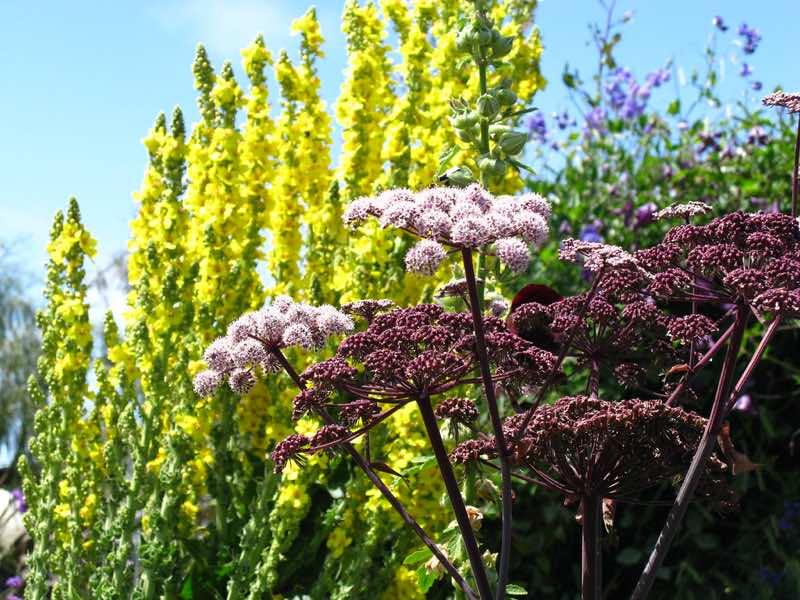
For example, the wind may carry the seed of an annual plant to a part of the garden where you may not have intended it to grow. Self-sowing annuals include the poppy, calendula, love-in-a-mist, love-lies-bleeding, pot marigold, verbena, and cleome.
When growing perennials indoors, it’s important to overwinter them below freezing temperatures, since they require to go dormant in a cold environment for around 10 weeks to bloom again next year. After around two years in a pot, you will generally want to move a perennial to a bigger pot.
Perennials: Some quick Facts
- Perennial blooms usually last up to six weeks while annuals can last from the moment they are planted throughout the entire summer.
- Around four years after planting, many perennials can be dug up and divided to make more flowers.
- Perennials may not always bloom during the first seasons after they’ve been planted, so you need to have patience with them.
- It’s best to plant perennials after the last frost, though you can plant hydrangeas and other perennials in the fall. This applies to potted plants you’ve received as a gift, too.
Perennial Flowers That Bloom All Summer
You wouldn’t mind having a colorful garden all summer long, right? Some perennial flowers bloom considerably longer than others and can last all through the summer.
Long-blooming perennials are the perfect choice if you want to create a garden that’s constantly in bloom during the warm seasons and that can make the butterflies jealous. Let’s take a closer look at some of the most beautiful long-lasting perennials around.
Perennials: Early Bloomers
Early bloomers put on showy flowers in the last weeks of spring so that by the time summer comes, they are already in bloom.
1. Stella de Oro Daylily
Available in beautiful varieties of yellow and gold, the Stella de Oro daylily blooms from May through July.
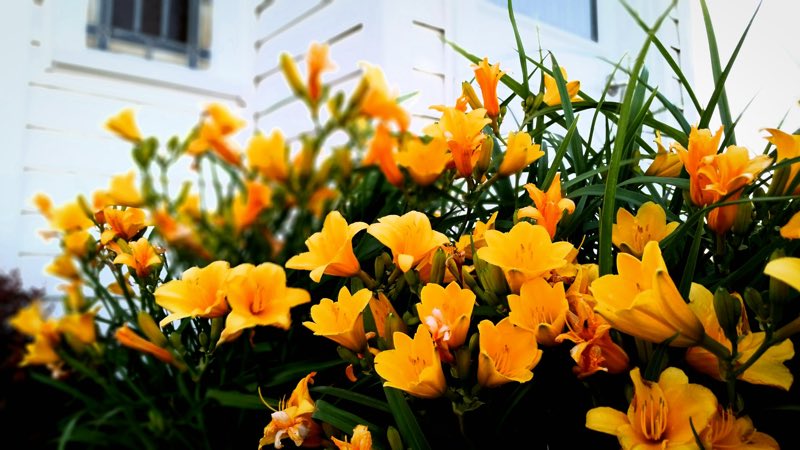
Individual blooms don’t last long, but this daylily keeps putting up new flowers that make it a wonderful early long-blooming perennial. It’s not a very demanding plant either—moderate exposure to the sun and medium-moisture are enough.
2. Walker’s Low Catmint
Blooming from spring through early fall, this cultivar grows up to 30”, which is more than twice the size of the common catmint.
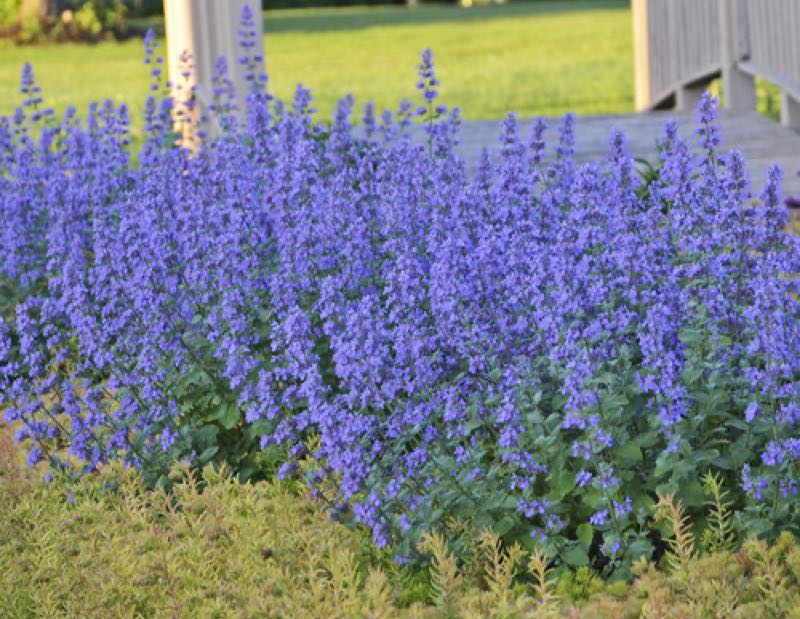
It’s a robust plant with lavender-blue flowers and aromatic leaves that you can stimulate to rebloom by shearing the first spikes after flowering.
Oh, and it won’t drive your cat crazy, so don’t worry—it’s catmint, not catnip!
3. Dalmatian Bellflower
Great for both edging and trailing over walls, the Dalmatian Bellflower comes in violet and blue varieties.
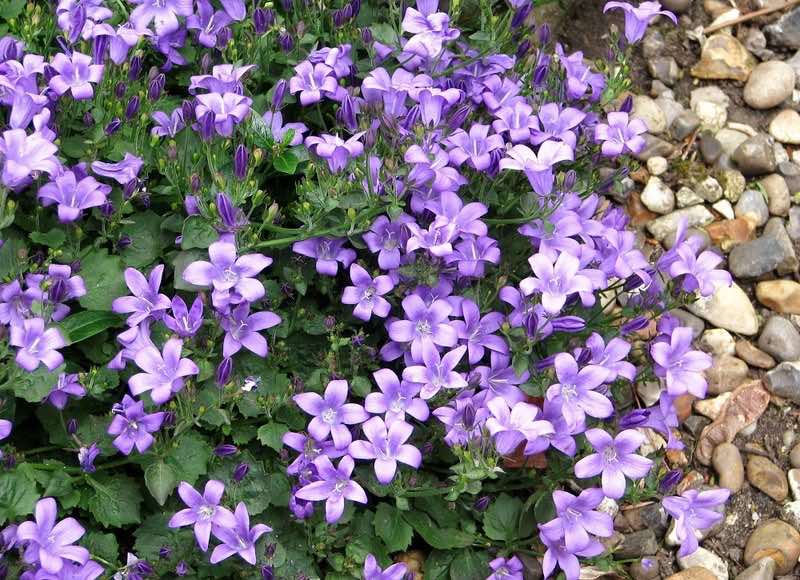
Starting in late spring or early summer, it blooms for around 8 to 9 weeks on average, creating a beautiful flurry of color.
4. Pincushion Perennial Flower
The Pincushion Flower or Scabiosa features a cushion-like crown and stamens that look like pins, hence the name.
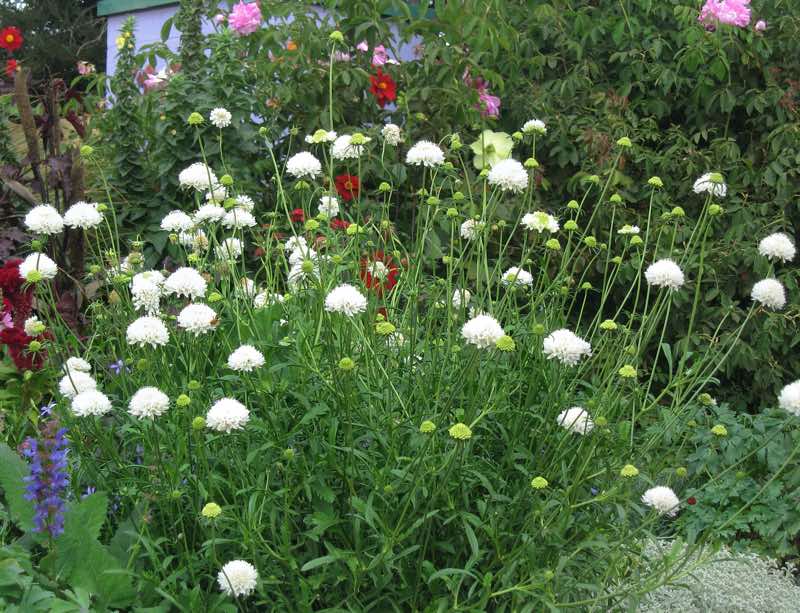
Compact and long-blooming, this purple, blue, or white flower blooms in late spring. Make sure to drain the soil properly for the plant to thrive.
Perennials: Mid-Season Bloomers
Mid-season long bloomers will display showy flowers come June or early July. They’re a terrific addition to any garden.
1. Yarrow Perennial
This herb plant can be red, white, yellow, pink, or rust-brown—so you can take your pick when it comes to the color.
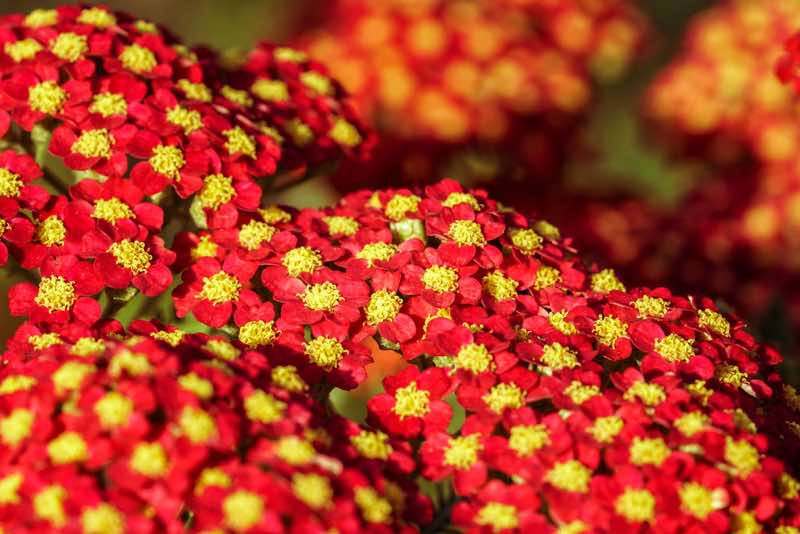
Plant it in a spot where it gets plenty of sun and it will bloom all summer long.
Tip: chewing fresh yarrow leaves can relieve toothache. If you want to learn more about this beautiful perennial wildflower, check out our yarrow guide.
2. Garden Phlox
With its beautiful starry flowers—pinkish-purple or white—garden phlox looks great throughout the summer.
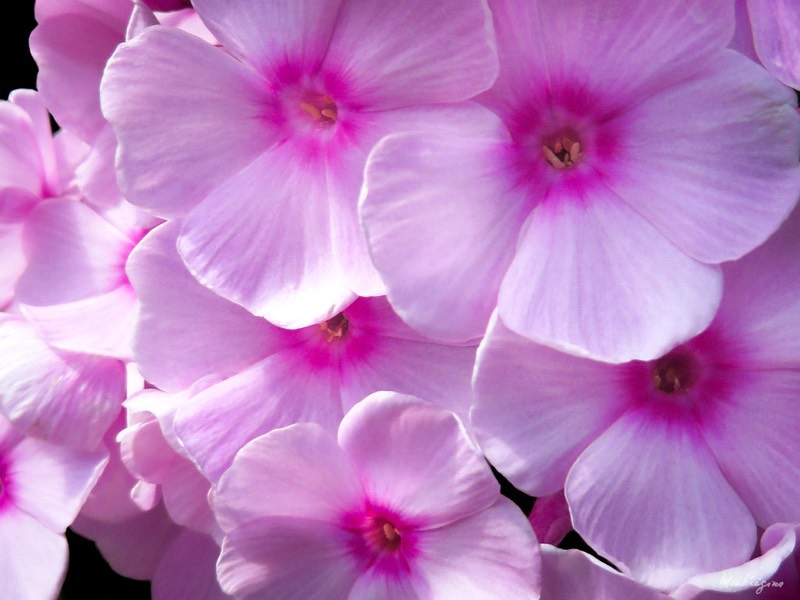
It prefers a well-drained, medium-moisture soil and part shade.
3. English Lavender
This popular variety of the lavender plant blooms in beautiful shades of purple and blue from June through August.
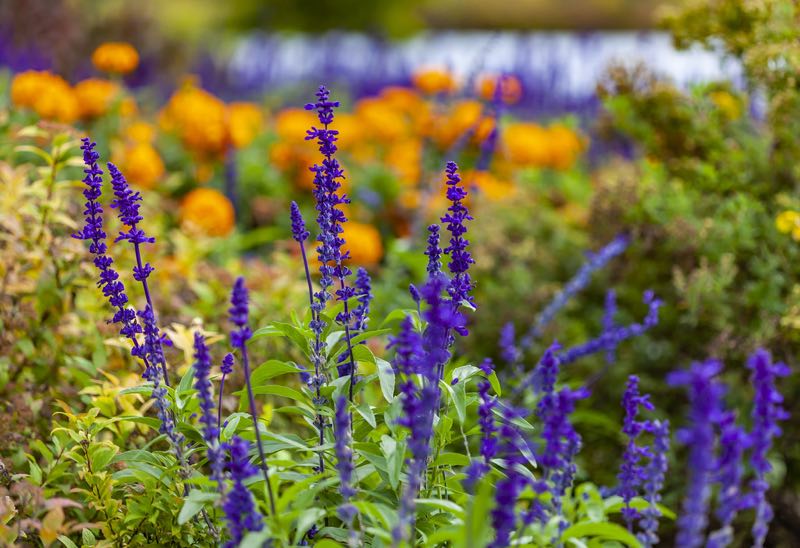
Its wonderful scent can turn heads. To keep the plant healthy, ensure that the soil is well-drained—moist soil can easily cause rot!
4. Perennial Salvia
Salvia plants include several long-lasting perennials like Salvia x Sylvestris, Salvia nemorosa, and Salvia Farinacea.
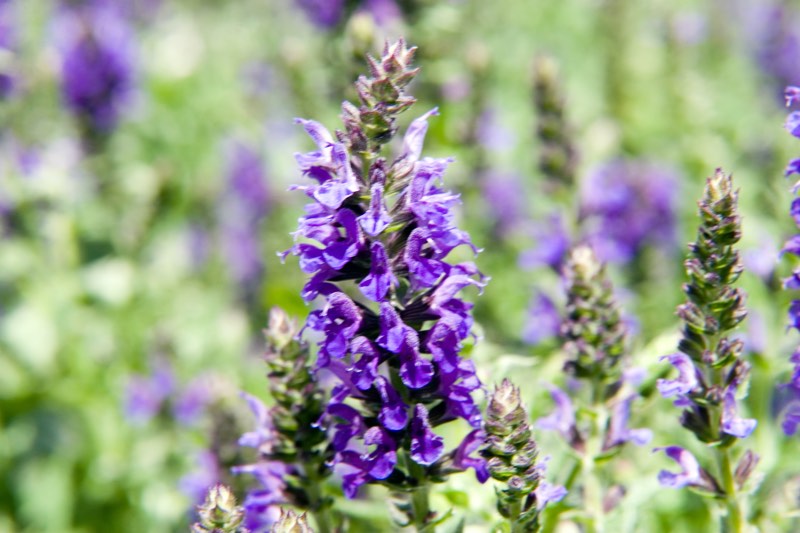
Within these varieties, you can find beautiful cultivars like Victoria Blue, Blue Hill, or May Night—all of which can bloom throughout the summer if you regularly remove the spent flowers.
5. Purple Coneflower
Growing up to 5’ in height, Echinacea purpurea blooms from June through August. It’s as beautiful as it is undemanding, and has good drought tolerance, too.
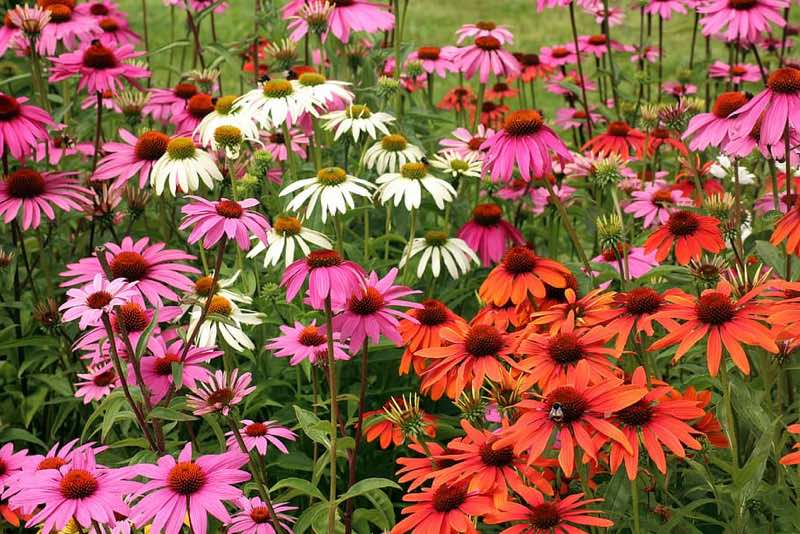
You can find yellow, orange, red, and white cultivars, so don’t take the color in the name for granted.
Perennials for Shade
Got a shady spot in your garden or house? It’s perfect for a perennial and probably waiting for it even as we speak. Discover now some wonderful perennial flowers for shade that can turn sheltered spots into eye-pleasers.
Partial-Shade Perennials
These perennial flowers like to be sheltered from the midday sun. Most of them won’t mind getting dappled sun during the day, but anything more than that can harm them.
1. Toad Lily
Don’t let the name trick you! The toad lily is a sweet and delicate orchid-like flower that comes in white or lavender, depending on the variety you choose.
2. Siberian Bugloss
Growing in clusters of small blue flowers, the Siberian Bugloss has large heart-shaped leaves with an interesting texture.
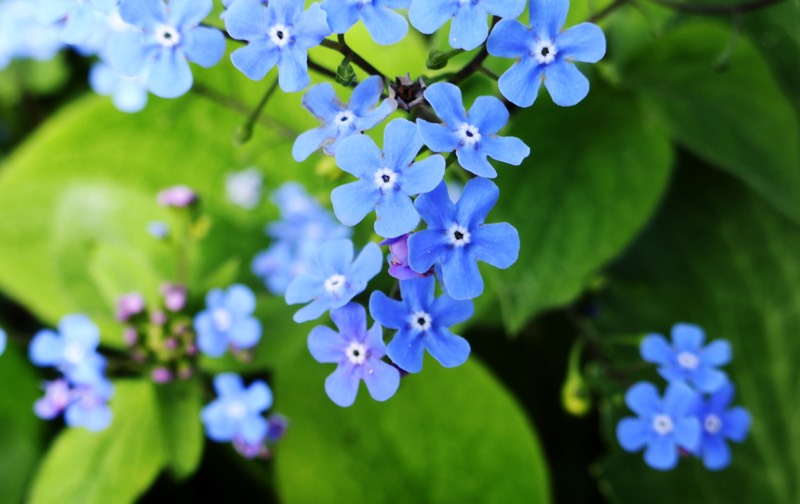
It’s also known as the great forget-me-not.
3. Old-Fashioned Bleeding Heart
The Bleeding Heart flower blooms (as the name already suggests) into pink heart-shaped flowers that hang from arching stems.
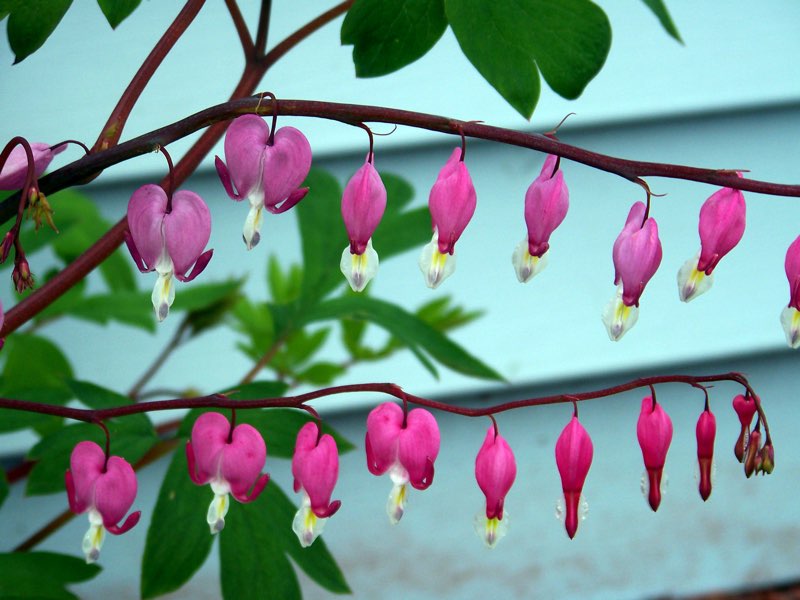
It can grow up to 4’ tall in partially shaded areas. This is an early blooming perennial, so it loses its flowers and foliage by midsummer.
4. Creeping Veronica
In early spring, this wonderful groundcover plant puts on bright blue flowers with a white eye in the middle.
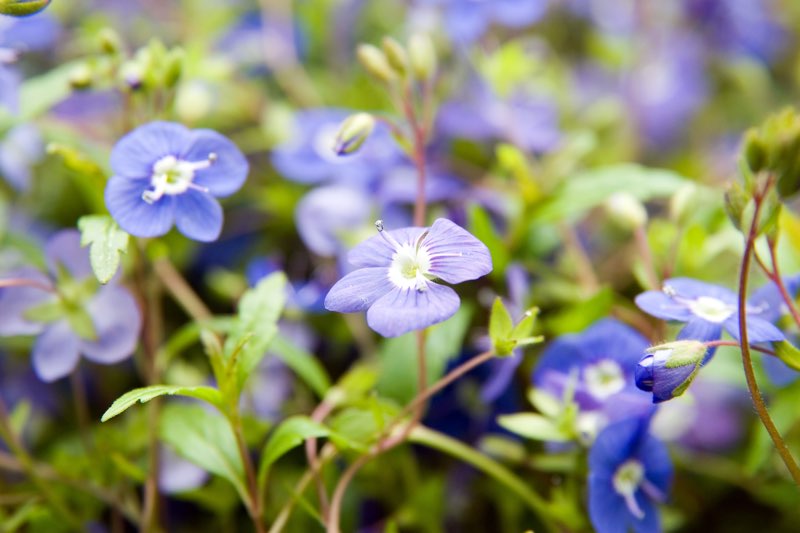
Most varieties come in shades of blue, including the popular Georgia Blue.
5. Celandine Poppy
Yellow Poppies? Why not! The yellow cup-shaped flowers of this shade-loving plant can bloom twice during spring and summer, provided you cut the flowers after the first bloom.
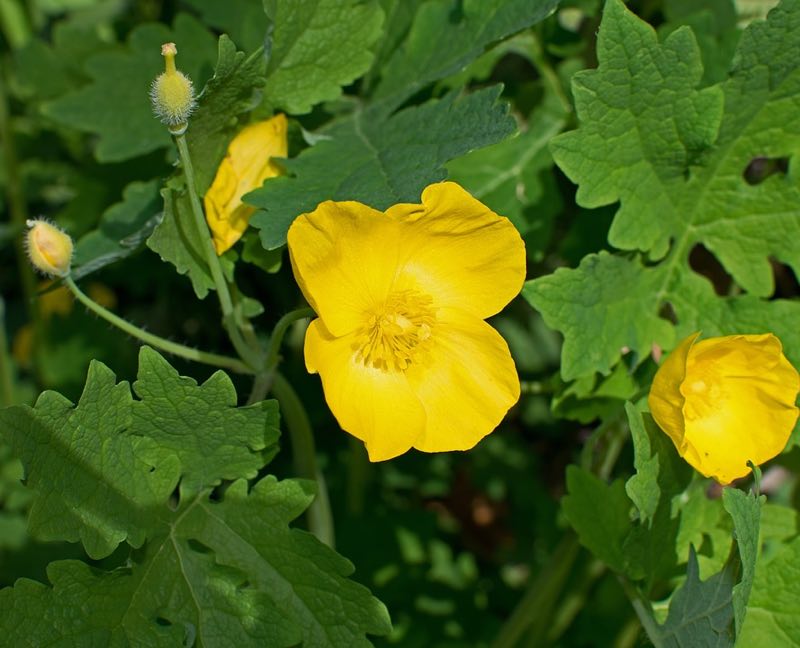
But watch out—this is a self-sowing plant, so you may have to keep an eye on its spread; it can take over a small garden in a few years.
6. Bear’s Breeches
Funny name aside, this partial-shade perennial flower has showy foliage and a bold thorn-covered stem edged with pinks and whites that can reach up to 5’ in height (feet, that’s right!).
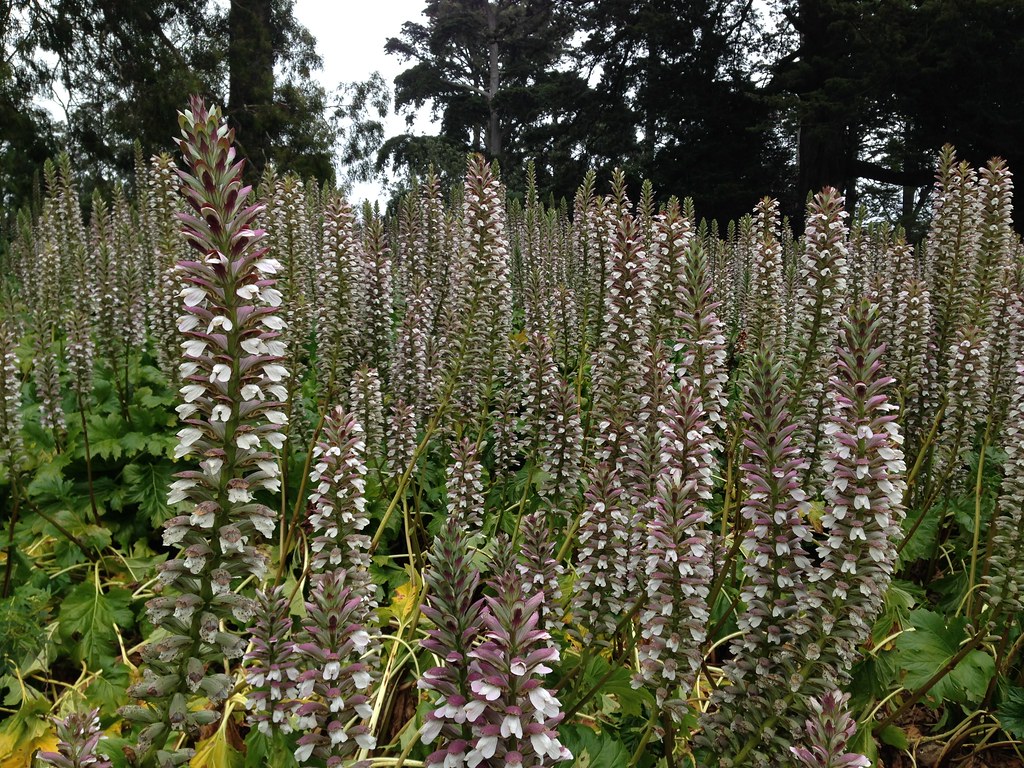
As you may imagine, you need plenty of space to grow this one, so it’s not recommended for small gardens.
7. Bunchberry
The Bunchberry wears yellow-green leaves and makes red berries in the fall.
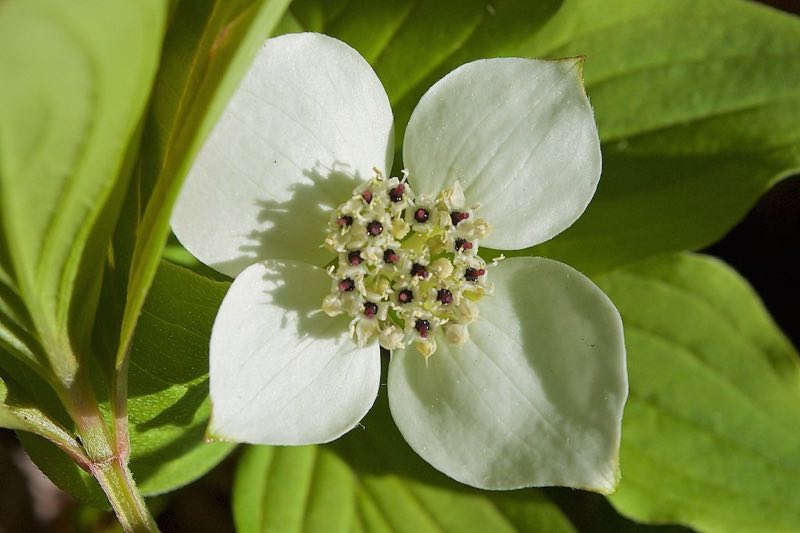
It’s perfect in spots of dappled shade, but it needs moist acidic soil to thrive.
8. Columbine Perennials
With its bright blooms—red, pink, purple, yellow, or white—the columbine or Aquilegia can brighten up any shaded spot.
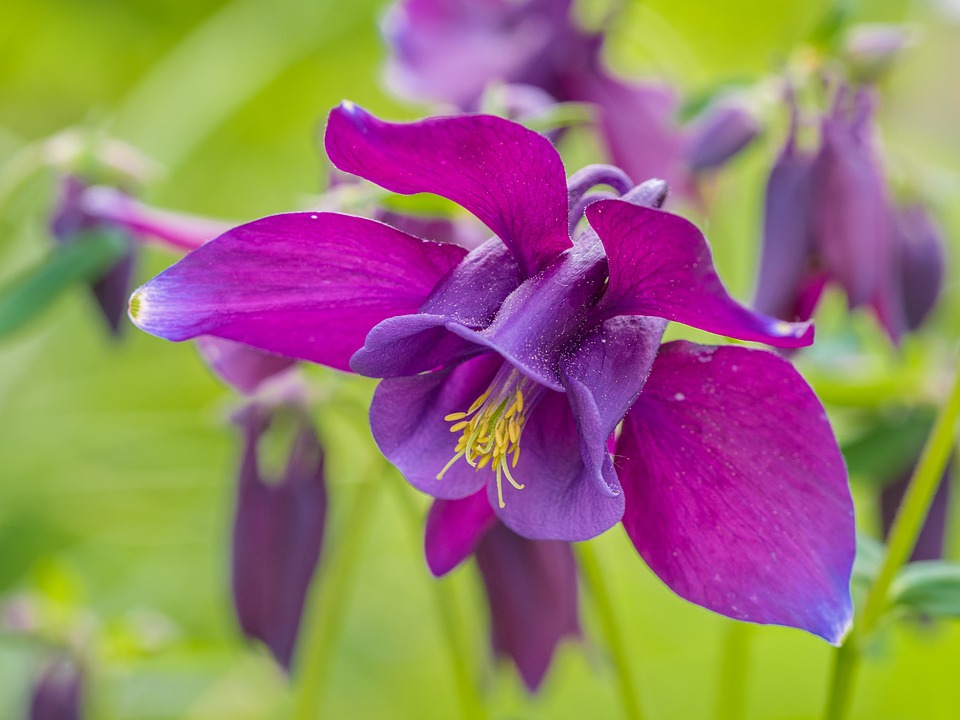
You’ll love the dainty bell shape of the flowers and the attractive dark foliage that turns a rusty color in the fall. It’s an easy plant to grow that calls only for good-quality compost.
Full-Shade Perennials
Do you have a spot in your garden that looks as if not even toadstools would grow in it? Don’t underestimate perennials! The following perennial flowers thrive in areas that get little to no direct sunlight, such as under a large tree or wall.
1. Yellow bleeding heart
This long-lasting perennial blooms into clusters of yellow tubular flowers and can propagate through seeds.
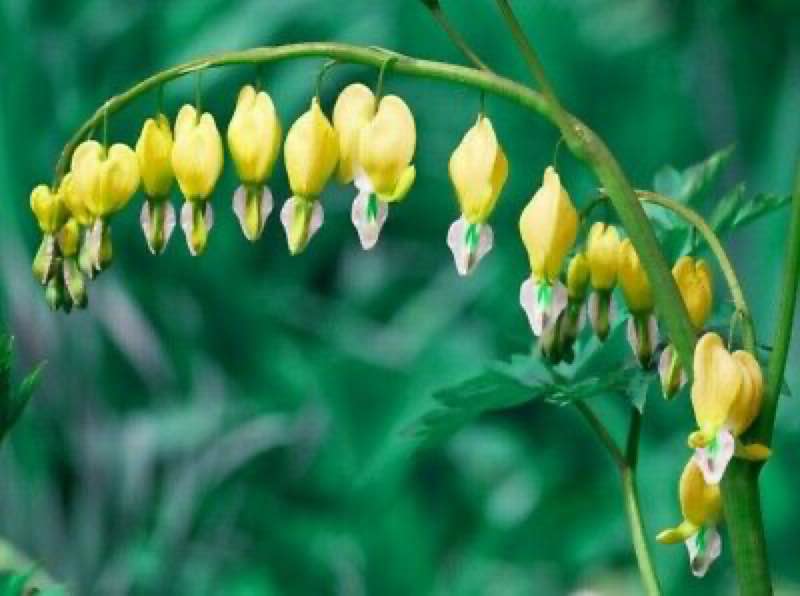
It can be an early guest in your springtime garden, blooming as early as April.
2. Fern-leaf bleeding heart
Pink, white, or red—this full-shade perennial flower grows in compact clusters up to 18” tall.
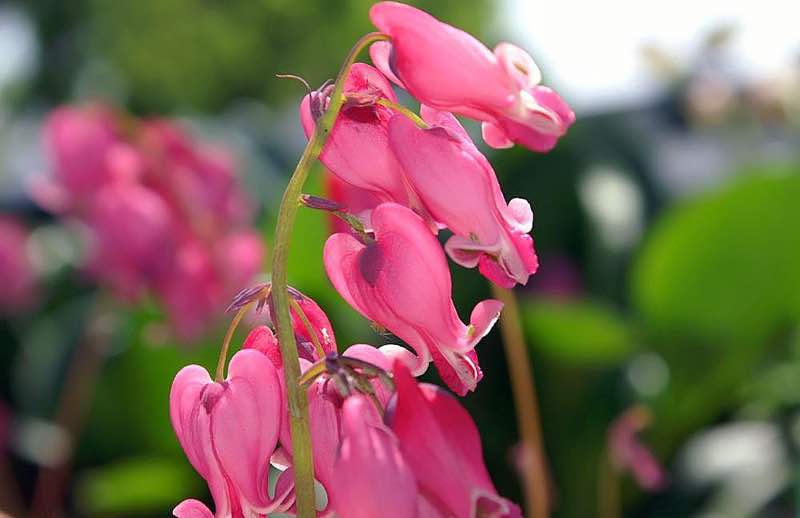
It doesn’t require much in terms of care. It’s also resistant to pests.
3. Indian Pink Perennials
Don’t let the name fool you. The Indian Pink blooms into long red flowers (instead of pink) that open into a delicate red/yellow star.
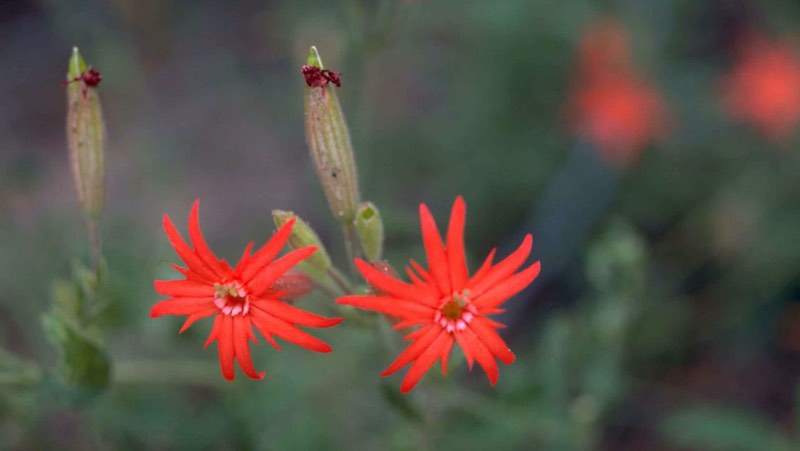
It’s a resilient plant that often grows over 1” in height.
4. Hardy Begonia
Known for its clusters of pink and red flowers, the Hardy Begonia has interesting heart-shaped leaves.
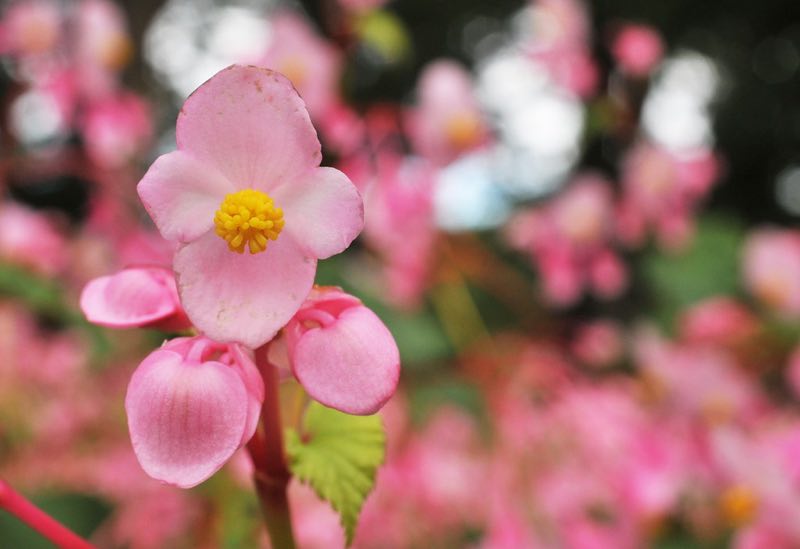
It’s a truly unpretentious begonia as far as shade goes. Shop around for it as there are many different cultivars.
5. Carpet bugle
The Carpet Bugle or Ajuga has rich foliage and spreads fast. It’s great for covering a medium-to-large area with a leafy perennial.
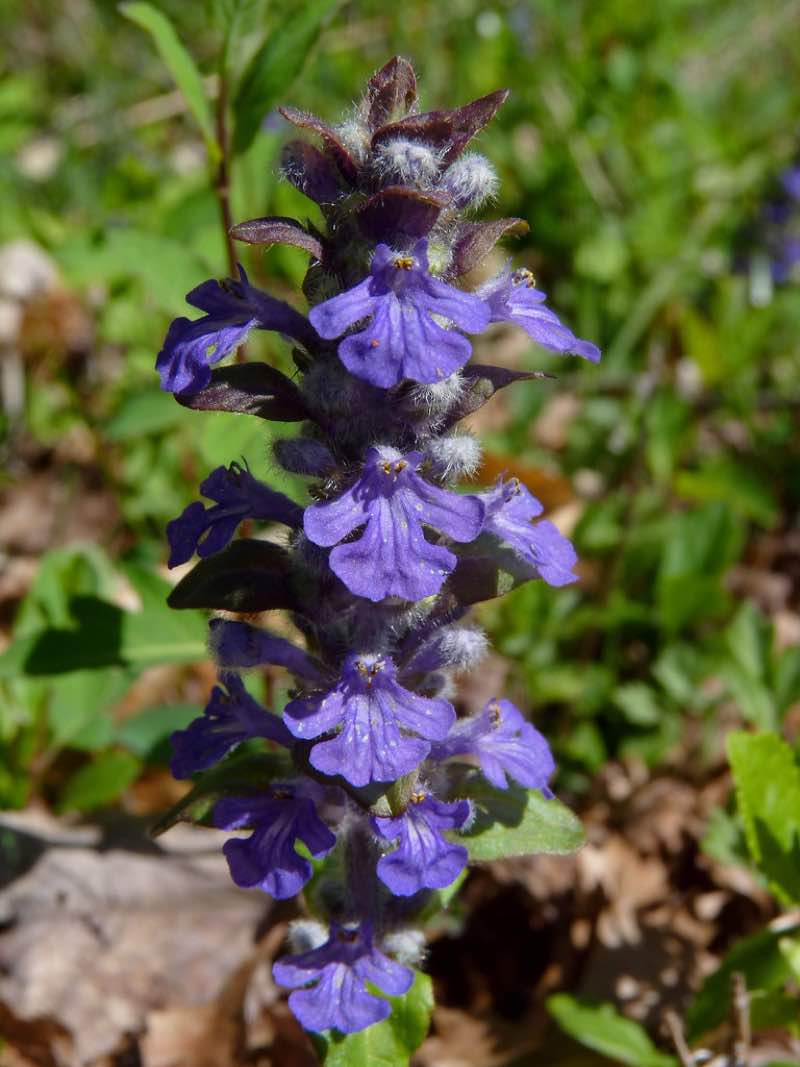
Plus, it grows deep purple flowers in spring.
Full Sun Perennials
We’ve talked about partial-shade and full-shade perennials, but now let’s go out into the sun with some perennial flowers that simply love the golden rays.
Full Sun Perennial Varieties
The following full sun perennials make sunflowers look, well, a bit boring. Coming in a rich array of colors, the definitely flower up your summer garden!
1. Sarah Bernhardt Peony
This exuberant pink Peony with large double flowers can look as striking in your garden as the famed French actress after which it was named used to look on theater stages in late 19th century Paris.
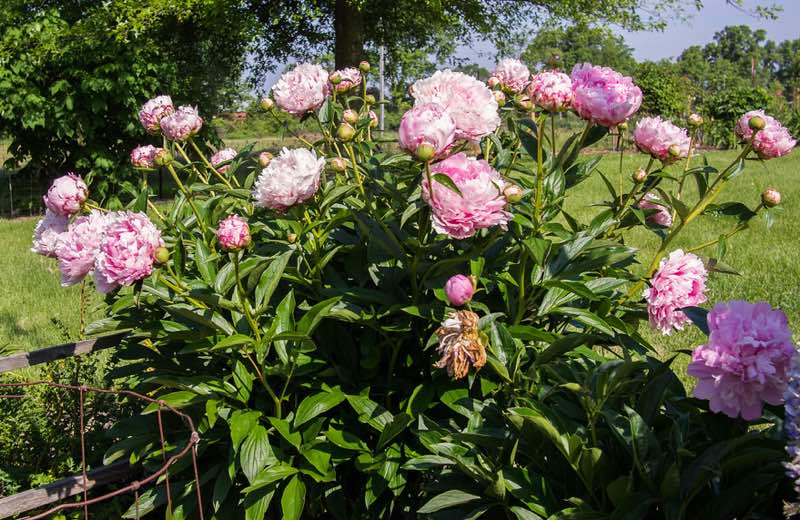
To ensure healthy growth, don’t plant it too deeply.
2. Veronica Spicata Royal Candles
The rich blue-violet spikes of this plant bloom throughout summer provided they get plenty of sun and a medium-moisture soil.
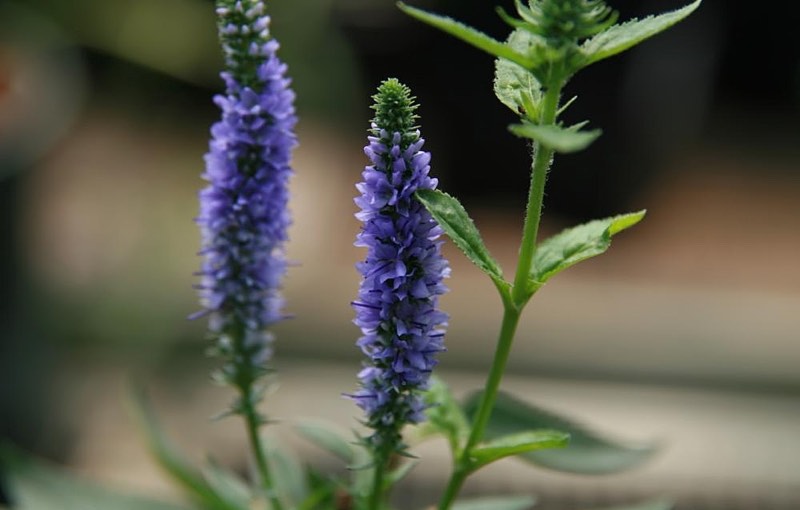
To explore taller varieties and other colors, notably pink and white, look for Spiked Speedwell cultivars.
3. Chrysanthemums
Chrysanthemums or “mums” as they’re often called, spring back to life every year, provided you plant them in the spring.
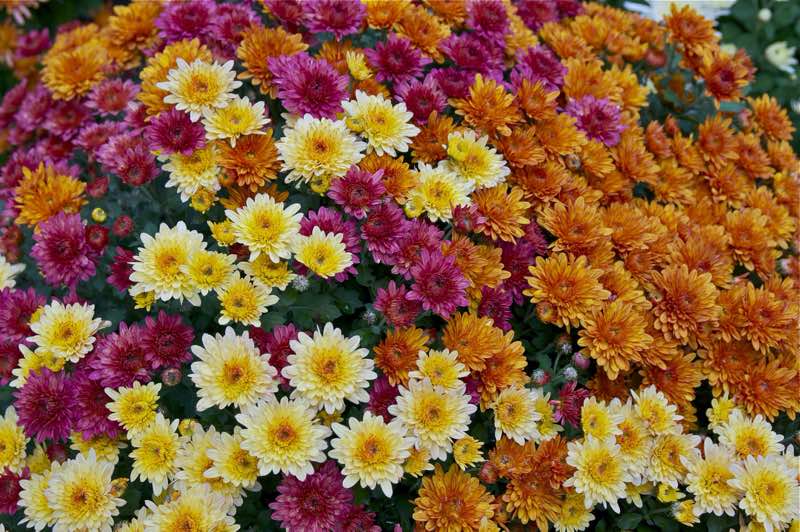
Many people mistake them for annuals, but that only because they plant them in the fall. Mums are available in most colors of the rainbow, including multiple colors per bloom.
4. Becky Shasta daisies
Daisies may be small, but they are some of the sunniest and most cheerful perennials you can grow in your garden.
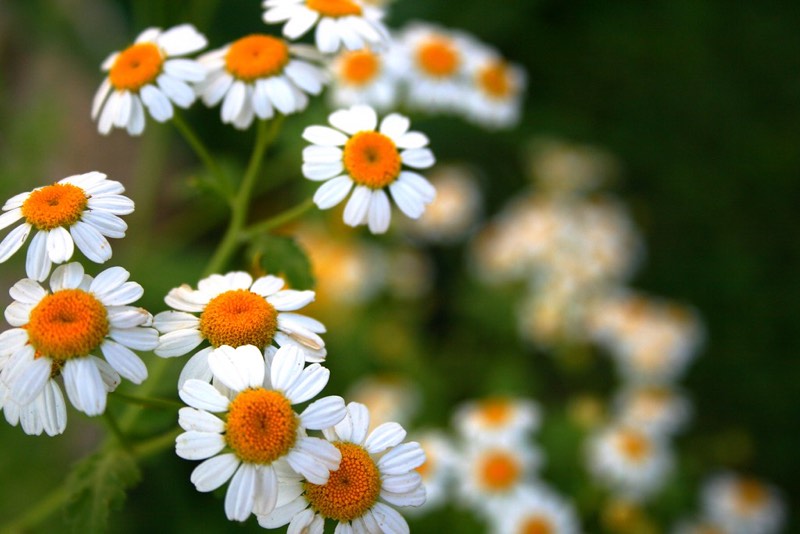
This variety is a resilient plant that loves the sun and can tolerate drought. It blooms from July to September.
5. Hardy Geranium
Hardy Geraniums bloom in early summer in a spray of colors that releases a spicy fragrance. Try out Geranium “Patricia,” which bears bright purple flowers that turn a wonderful red in the fall.
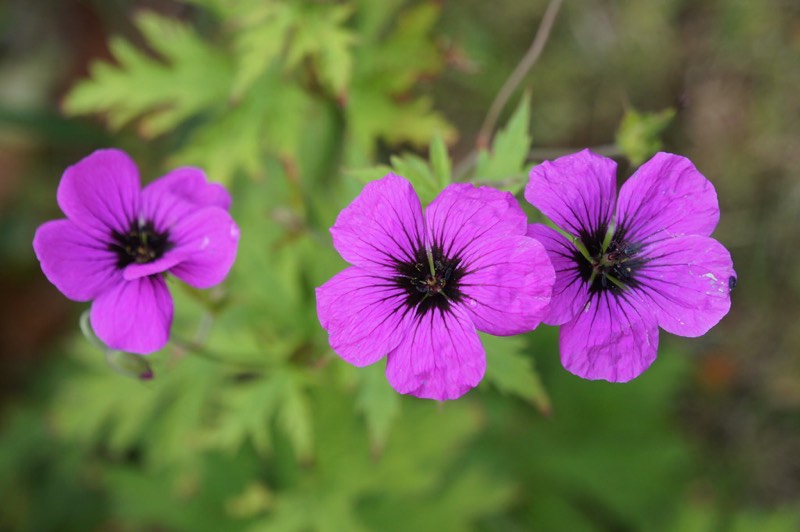
Another interesting cultivar is the large, violet-blue Geranium “Rozanne,” which blooms throughout summer. Hardy Geraniums are easy to look after—they just need well-drained, moderately fertile soil.
6. Lamb’s Ears
Lamb’s Ears dazzles not so much with its flowers as with its fuzzy white leaves.
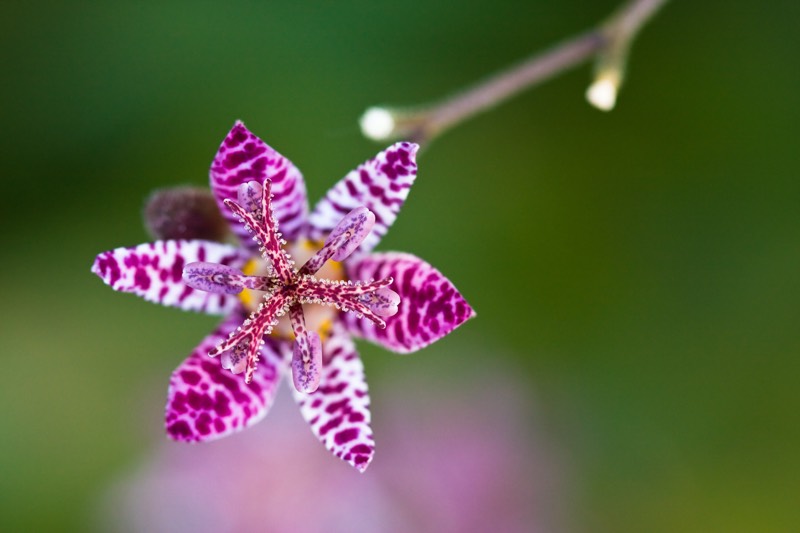
It’s a dense bedding plant that can cover sparse areas in a garden. It bears pink or purple spiked flowers.
7. Dianthus
There are around 300 species in the Dianthus genus, which includes the carnation—but not all of them are perennials.
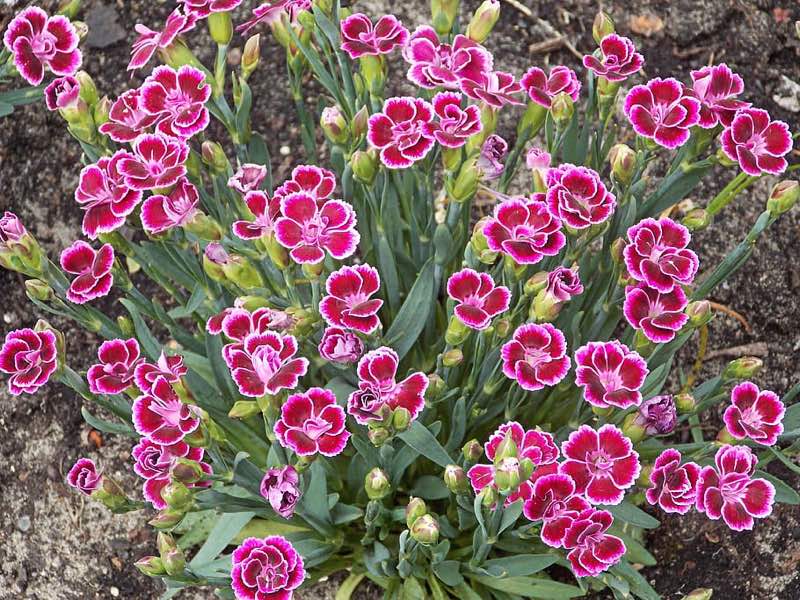
Look for D. Deltoides, D. Superbus, and D. Plumarius which come in red, bright pink, or pale purple.
8. Threadleaf Coreopsis
Threadleaf Coreopsis usually flowers in early summer, but you can stimulate a second, late growth after the first flowering.
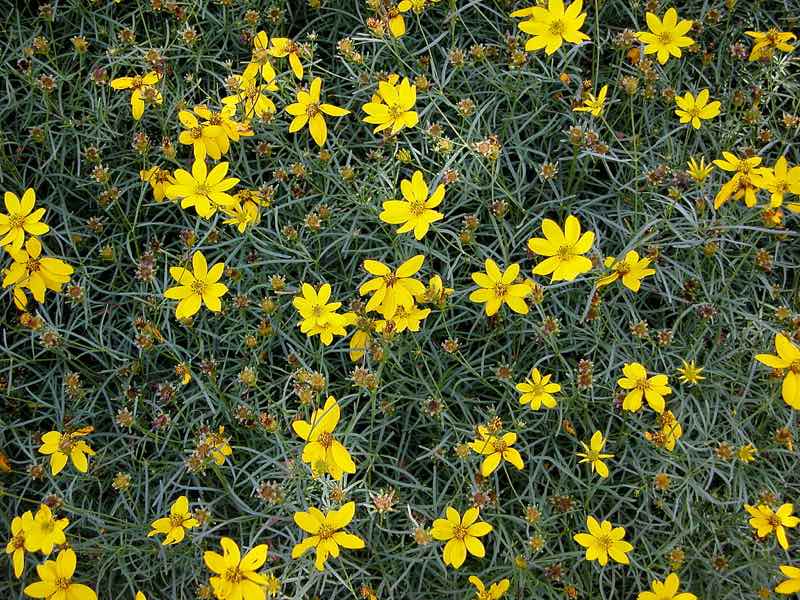
This sun-loving and not very thirsty plant comes in a vibrant yellow that can add richness to any garden design.
9. Rock Cress Perennials
A perfect plant for borders in rock gardens, the rock cress blooms into a profusion of vivid purple or red flowers.
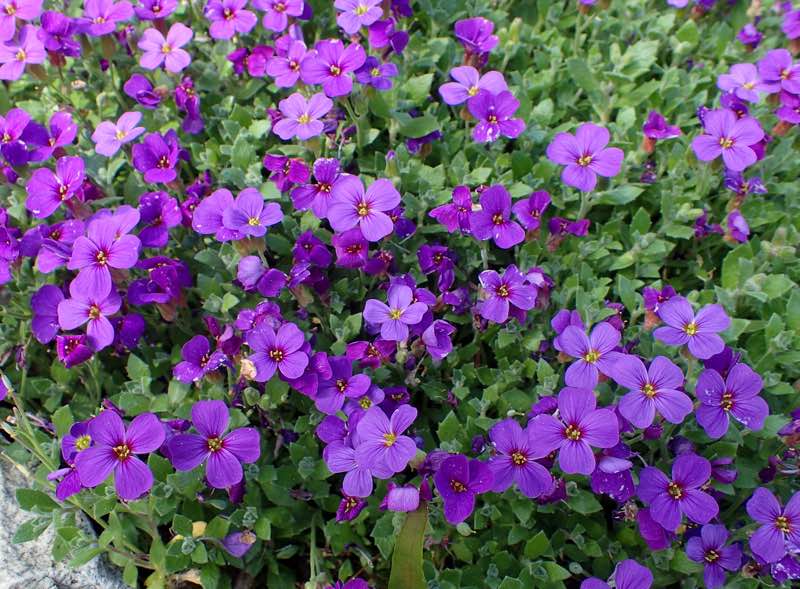
The rock cress spreads best in sandy or rocky soils, including slopes.
10. Candytuft Perrenial Flower
In spring, the Candytuft puts on a rich show of white or purple flowers that contrast with its glossy leaves.
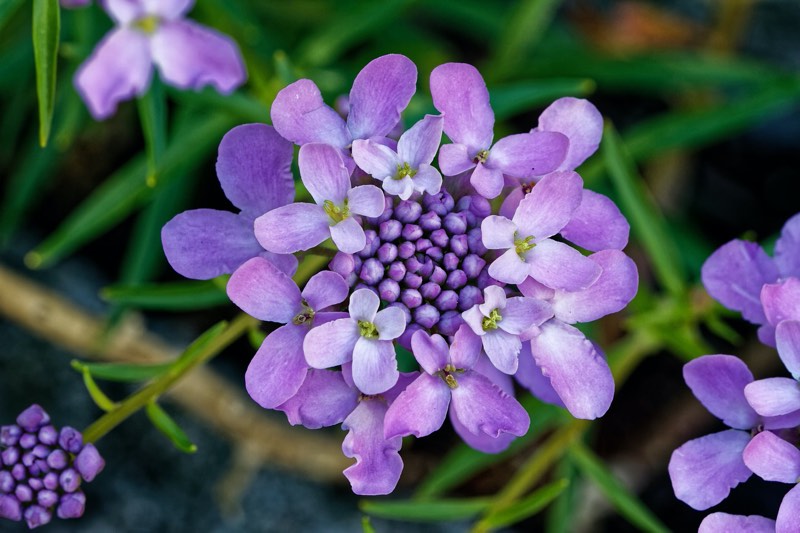
It likes full sun and well-drained soil.
11. Autumn joy
The rosy-pink buds of this stonecrop flower deepen to a rusty red starting late summer or early fall. You’ll love its rich clumps of colorful flowers and its general unpretentiousness.
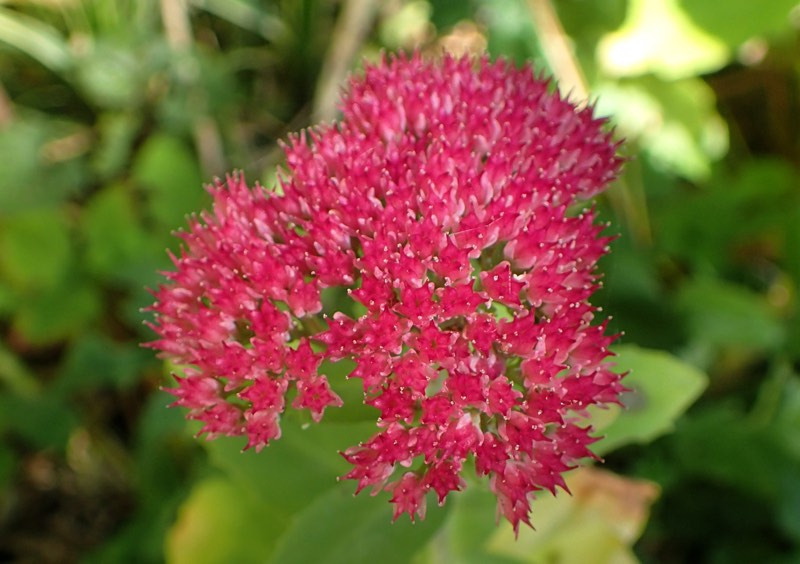
Just ensure it gets dry to medium moisture and full sun, and it will last for years.
Tall Perennial Flowers
When landscaping your garden, keep in mind that you can work with different dimensions. Not only color combinations can create a stunning effect, heights can also amplify the beauty of every plant in your garden. The good news is that there are lots of beautiful tall perennial flowers that will lift your garden far off the ground.
Tall Perennial Varieties
Whether you’re looking for background perennials for your garden or just need some tall flowers for a specific spot in your home, as mentioned above, tall perennials are well worth your attention. Explore some of them now.
1. Maximilian sunflower
Named for the German prince and explorer, the Maximilian Sunflower or Helianthus Maximiliana, can grow up to 10’ tall.
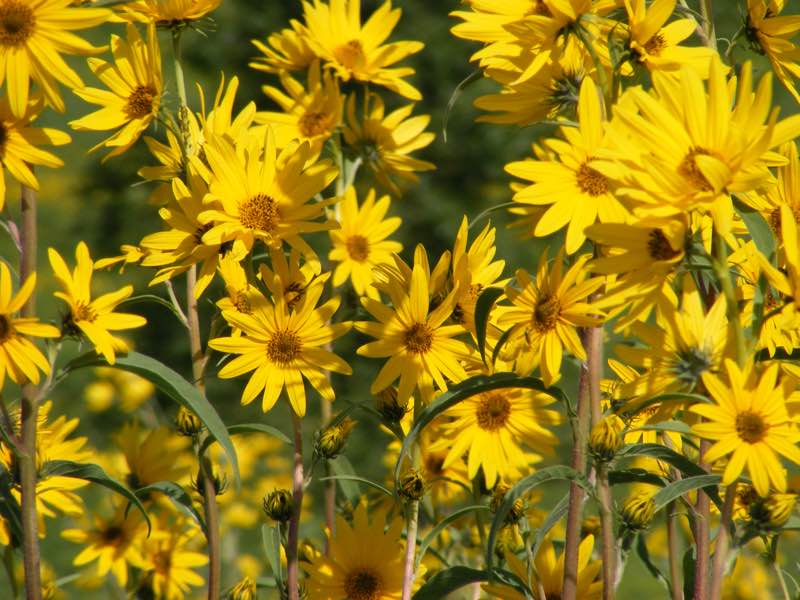
It has oval or heart-shaped leaves and vibrant blue flowers that bloom towards the end of summer. If its name hasn’t given it away by now, keep in mind that it likes full sun!
2. Peonies Perennials
White, lavender, pink, yellow, or red—whichever the color, peonies put on a spectacular show every spring.
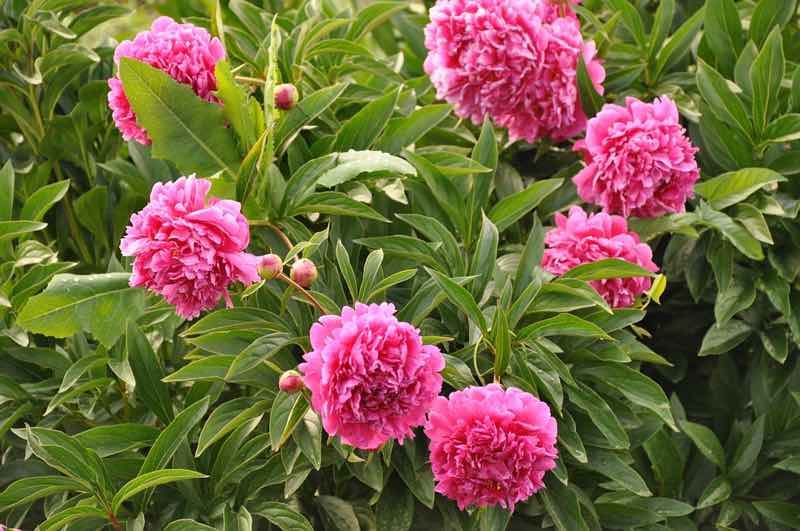
In a safe and sunny spot, peonies can grow up to 3’ in height. They are otherwise undemanding and can thrive in most soils given good drainage.
3. Dictamnus Albus
One of the rarer plants on this list, the Dictamnus Albus or burning bush is worth searching for as it can produce beautiful and fragrant flowering spikes for years.
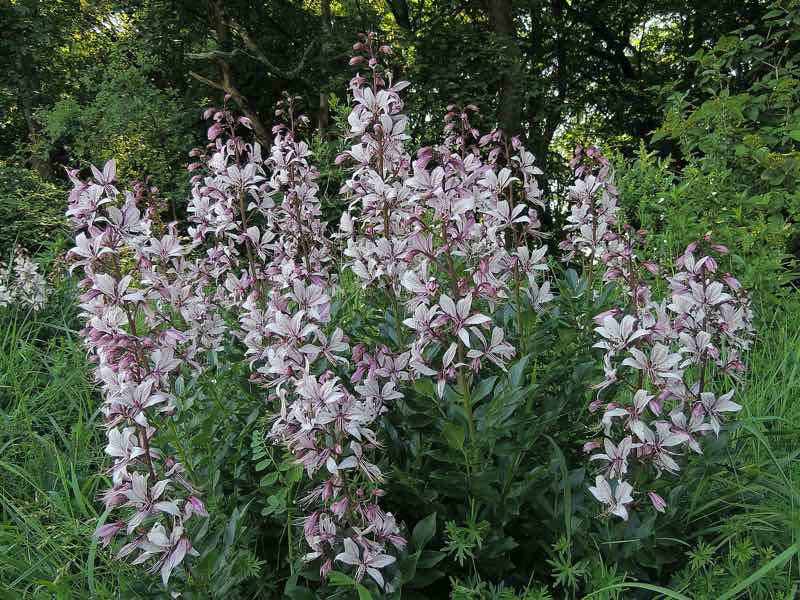
The plant reaches up to 3’ given well-drained soil and full exposure to the sun. The plant is a beautiful addition to your garden, given that the light pink flowers combine really well with other colors and plants.
4. Eremurus
One of the tallest perennials on our list, Eremurus or Desert Candle can reach 12’ in height, with a spread half as big. Blooms grow in a high yellow cluster that resembles a burning candle and spread a pleasant fragrance.
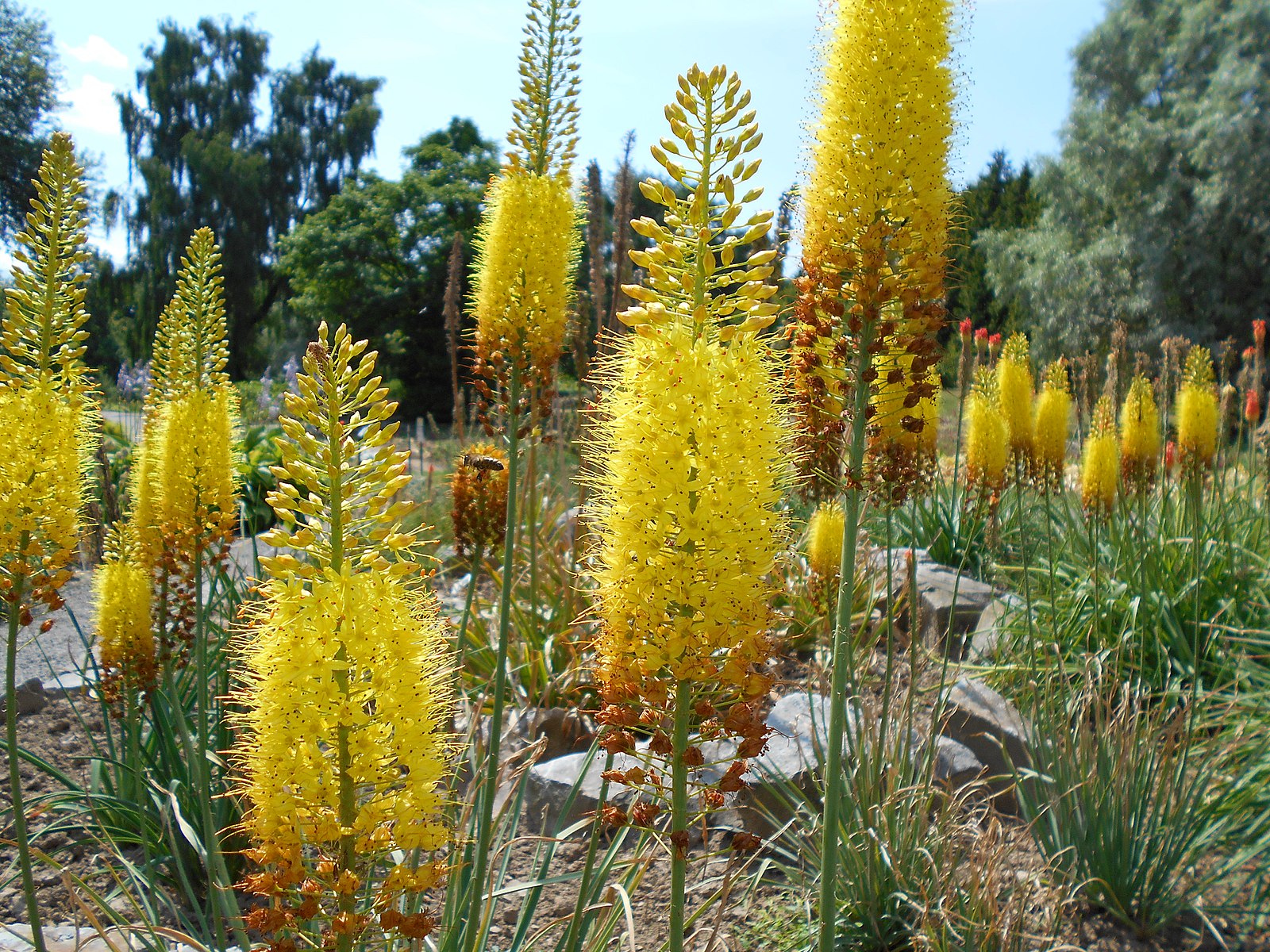
Plant them in a spot where they are protected from the wind, since the tall stalks may easily snap.
5. False Aster
The False Aster or Boltonia is a wildflower that blooms into dozens of aster-like flowers starting in early spring.
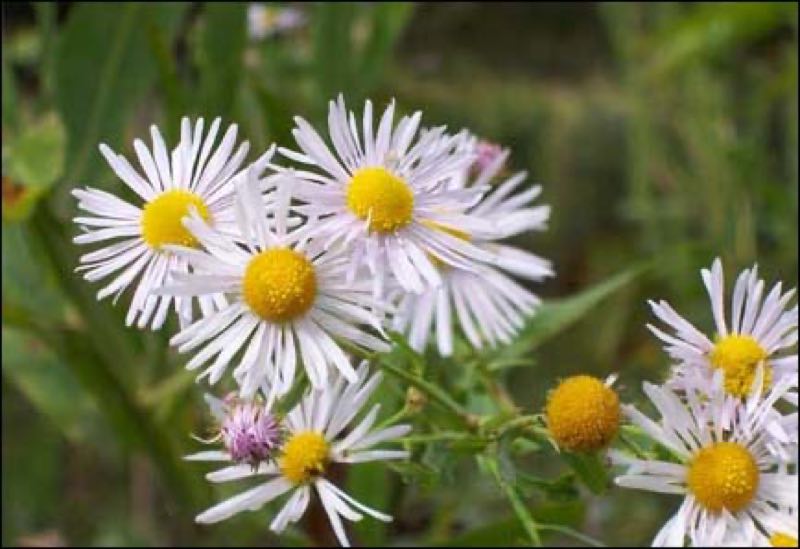
The long stems can reach up to 8’ in height. This plant thrives in moist soil and full sun.
6. Yuccas Perennials
With their sword-like leaves and creamy-white flowers, Yuccas are an interesting sight to say the least, especially since they can grow up to 10’ tall.
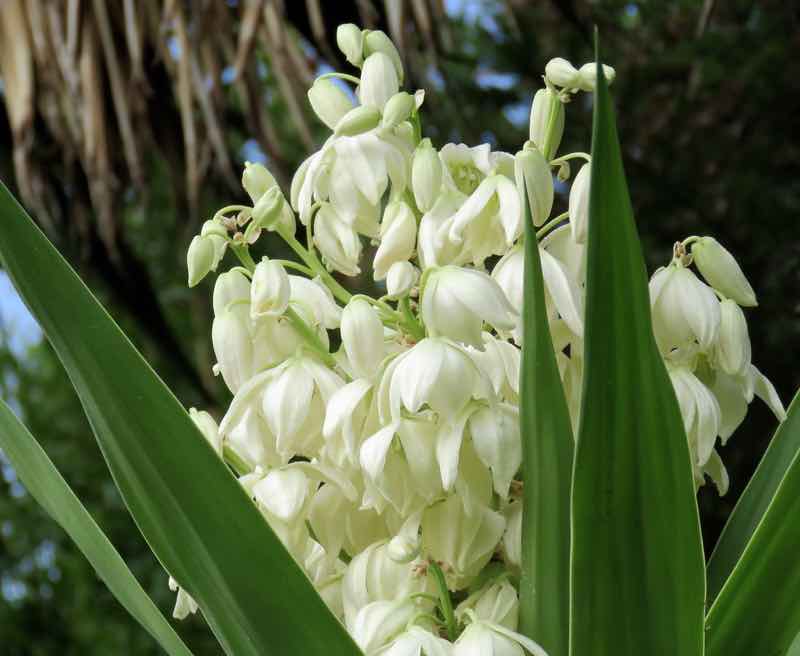
Yuccas require little in terms of maintenance and don’t mind staying in the sun most of the day.
7. Common Foxglove
Mostly rose or violet, the tall spires of the Common Foxglove can reach up to 5’ at the height of summer.
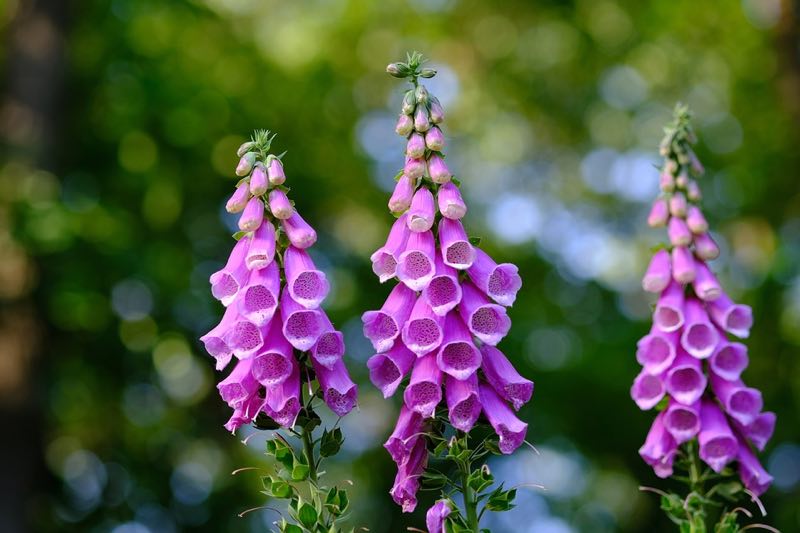
If you want to add charm to an old or plain garden wall, this could be the tall perennial you’ve been looking for.
8. Globe Thistles
The whimsy globe thistle has gray-blue blooms with thistles that resemble somewhat those of a hedgehog.
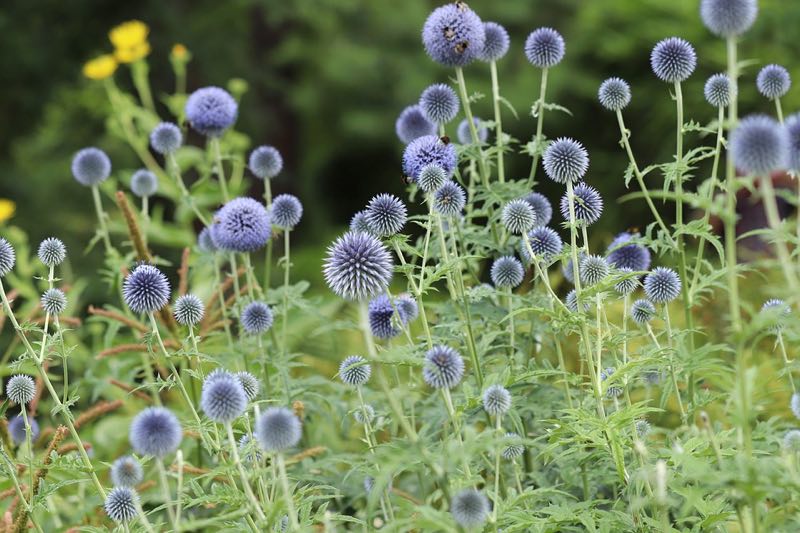
The distinctive spherical blooms catch the eye. Globe thistles can grow up to 4’ in height.
9. Everest White
Also known as Rose mallow, this pure white flowers with a central rosy eye grows amid a column of foliage.
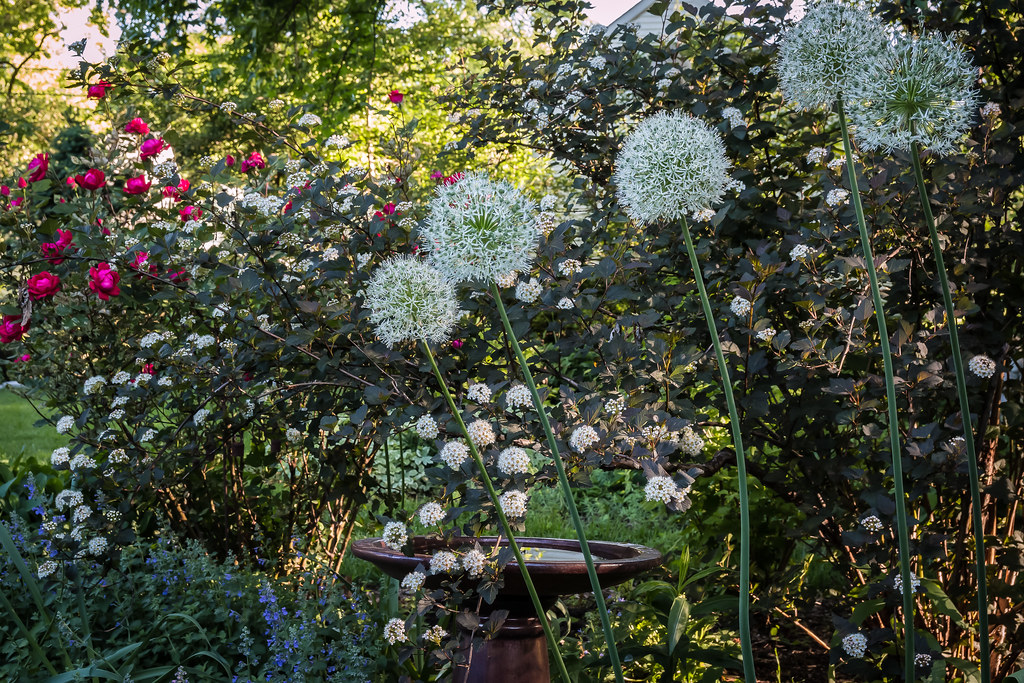
You’ll be hard pressed to find a more dazzlingly white tall perennial. It grows up to 7’ in height.
10. Valerian
With its lacy white or pink blossoms, the Valerian remains dainty despite the 5’ that it can reach at maturity.
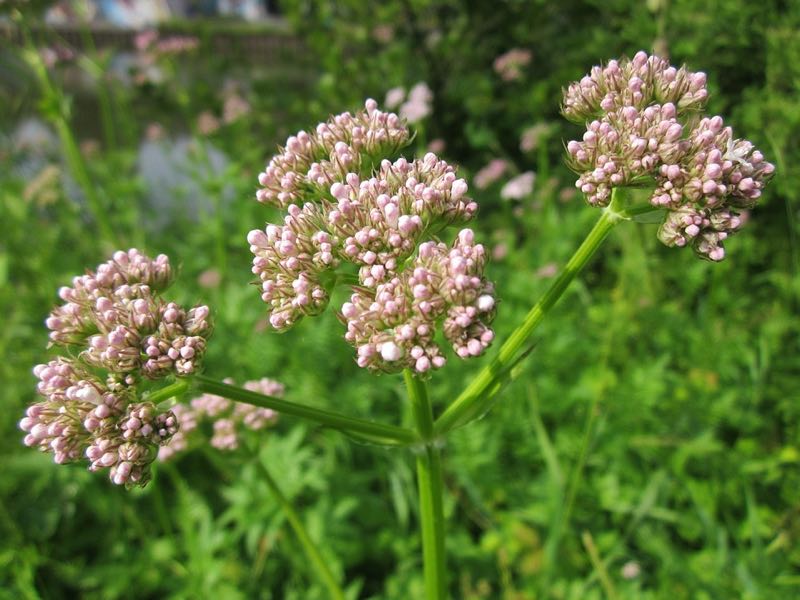
Relatively easy to grow, it can stand cold spells.
Perennials FAQ
What kind of flowers are perennials?
Perennials spring back to life every year without requiring replanting. Popular perennials include the daylily, hosta, salvia, veronica, dianthus, lavender, and catmint.
What flower comes back every year?
Perennial flowers that grow in good soil and get enough exposure to the sun come back to life every year. Enduring perennials include the daylily, hellebore, coneflower, iris, hellebore, butterfly weed, geranium, and peony.
What is the difference between annuals and perennials?
Perennials bloom every year between spring and late summer, unlike annuals which flower and die in one season. Perennials don’t need replanting to rebloom provided they go dormant during the winter.
What perennials bloom the longest?
The following types of perennials often bloom for months, not just weeks: the daylily, catmint, yarrow, garden phlox, English lavender, Dalmatian bellflower, salvia, and coneflower
Enjoy the Enduring Beauty of Perennials
Perennial flowers come in a rich profusion of colors and scents. They grow in the sun as well as in the shade and cover the ground with a carpet of evergreen leaves or grow on stems taller than most people. They can even bloom repeatedly during the warm months and stay in bloom until mid-autumn.
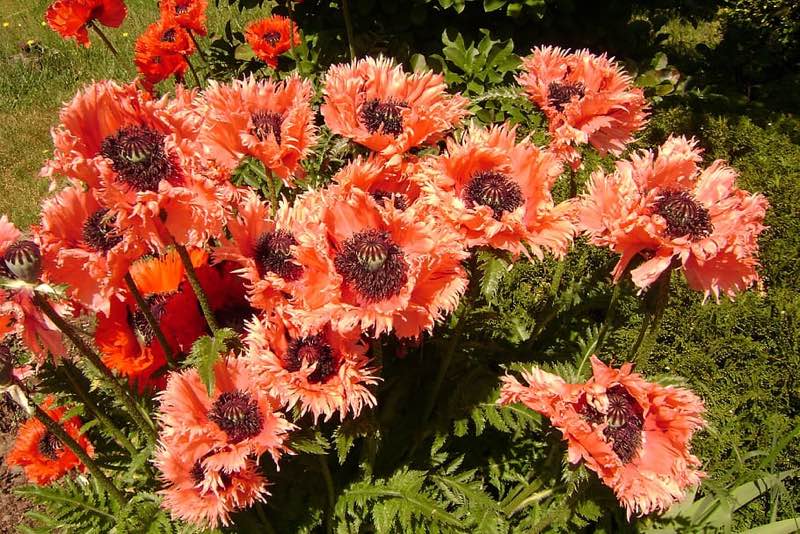
Perennials are hardy and dependable plants that you can count on to add richness to your garden or indoor displays throughout the year, not just in spring. Even when the flowers wilt, the leaves tend to stay.
With so many perennial flowers to choose from, the only question is which varieties will you add to your garden or pots the next growing season? Pick any of the perennial flowers we shared with you and you won’t regret it!

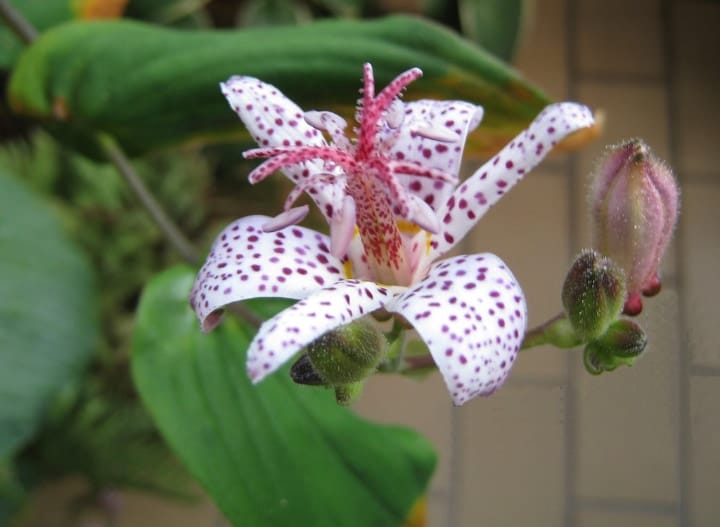
Thank you for comprehensive and extensive flower guide. WOW!!! It is the best I have ever found. THANK YOU! THANK YOU!!